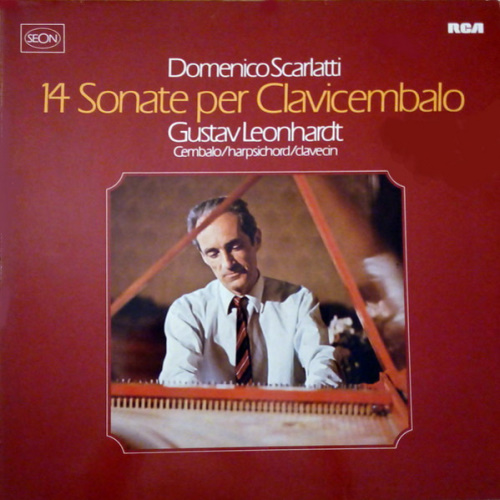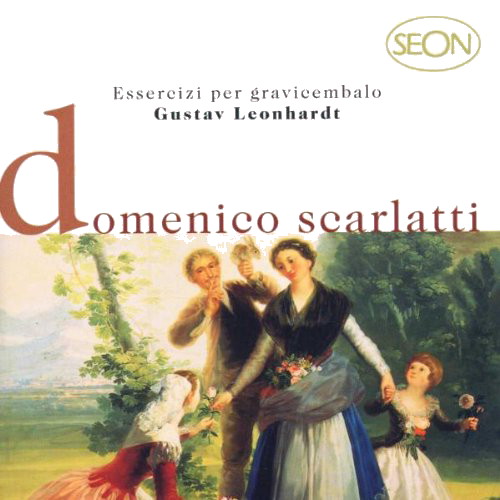 |
1 LP -
RL 30334 - (p) 1979
|
 |
| 1 CD -
SBK 60099 - (c) 1998 |
|
14 SONATE PER
CLAVICEMBALO AUS "ESSERCIZI PER
GRAVICEMBALO"
|
|
|
|
|
|
|
|
| Domenico SCARLATTI (1756-1791) |
Sonata
in A minor, K 3 |
|
3' 00" |
A1 |
|
Sonatas
in F-Minor, K 184 / 183
|
|
7' 33" |
A2
|
|
Sonata
in B Minor, K 227
|
|
3' 37" |
A3 |
|
Sonatas
in F minor, K 238 / 239 |
|
6' 58" |
A4 |
|
Sonata
in D Minor, K 52 |
|
4' 18" |
A5 |
|
Sonatas
in E-flat Major, K 192 / 193
|
|
7' 20" |
B1 |
|
Sonatas
in A Major, K 208 / 209 |
|
6' 18" |
B2 |
|
Sonataa in E-flat Major, K
252 / 253 |
|
6' 28" |
B3 |
|
Sonata
in D Minor, K 191
|
|
2' 20" |
B4 |
|
|
|
|
|
Gustav Leonhardt, Harpsichord (Martin Skowroneck,
Bremen, after J. D. Dulcken, Antwerp,
1962)
|
|
|
|
|
|
Luogo
e data di registrazione |
|
Haarlem (Holland) -
Settembre 1978 |
|
|
Registrazione: live
/ studio |
|
studio |
|
|
Producer /
Recording Supervisor |
|
Wolf Erichson
|
|
|
Recording Engineer
|
|
Dieter Thomsen
|
|
|
Prima Edizione LP |
|
Seon (RCA Red Seal) |
RL 30334 | 1 LP - durata 48' 36" |
(p) 1979 | ANA
|
|
|
Edizione CD |
|
Sony | SBK 60099 | 1
CD - durata 48' 36" | (c) 1998 |
ADD
|
|
|
Original Cover
|
|
Foto SEON / D.
Thomsen
|
|
|
Note |
|
- |
|
|
|
|
Domenico
Scarlatti discovered his
musical identity relatively
late in life. Born in
Naples, the son of the
famous opera composer
Alessandro Scarlatti,
Domenico Scarlatti tended at
first to be overshadowed wed
as a composer by his great
father. The work he wrote
while holding an official
music in Rome reveal little
that is original. It was
only when he finally left
Italy and broke free from
the restraints of tradition
that his unique creative
personality began to take
shape.
For nearly ten years
Domenico Scarlatti was
employed at the court of
Joāos V, King of portugal,
as court conductor and music
teacher to the talented
young Princess Maria
Barbara. When, in 1729, at
the age of 18, his young
pupil married the Spanish
infante, Fernando VI, she
took her "true and devoted
music-master" with her to
Spain. It was here finally,
in 1738, that his "Essercizi
per Gravicembalo" was
published, a work which
established his fame as a
composer for the
harpsichord. In the years
that followed, over 500
sonatas were added to this
first collection. Two richly
ornamental manuscripts were
prepared in 1742 and in
1749, presumably by royal
command, and between 1752
and 1757 Queen Maria Barbara
had a further 13-volume
collection of Scarlatti's
sonatas copied and
splendidly bound in Morocco
leather. In 1835 this
"royal" collection was
acquired by the Biblioteca
Marciana in Venice. Together
with the "Essercizi" these
15 magnificent volumes form
the main resource of
Scarlatti's harpsichord
works. In the preface to his
"Essercizi" Scarlatti
requested that one should
not look for profound
scholarship in his sonatas,
but rather "lo scherzo
ingegnoso dell'arte,",
ingenious play. A great zest
for life and spirit of
enjoyment are reflected in
these finely polished gems
of Mediterranean brilliance
and clarity. Scarlatti bever
ventures from his
binary-form scheme for any
of his single-movement
sonatas, though he does
evolve various modifications
of the form. Despite this
restriction the sonatas, 555
in all, prove to be of
infinite variety, abounding
in imaginative ideas, a
veritable microcosm of
moods. Already in the
earlierst sonatas Scarlatti
created a style of keyboard
writing that was extremely
original. He managed to
blend together ideas taken
from Italian harpsichord
music, Italian opera and
Iberian folkmusic and also
developed a sparkling
virtuoso style (with great
leaps, rapid crossing back
and forth of the hands, and
strings of trills) which
demanded exceptionally high
technical skill of the
performer.
The Sonata in A minor K. 3
(L. 378) is one of the early
1738 "Essercizi", a study
rich in chromaticism and
chords of the diminished
seventh. The legato D minor
Sonata K. 52 (L. 267) is
also a relatively early
piece. In the B minor Sonata
K. 227 (L. 347) Scarlatti
experiments with frequent
changes of beat from 2/4 to
(Napolitan) 3/8 time.
Indeed, quite a number of
the sonatas are obvious
attemps to incorporate
Iberian folkmusic. Ralph
Kirkpatrick regards the A
major Sonata K. 208 (L.
238), for instance, as
flamenco music for the royal
apartments, and in the
Sonata in A major K. 209 (L.
428) he reckons one can
clearly detect not only the
ubiquitous castanets but
also stamping heels and
whirring feet. Strains of a
Portuguese folksong from
Estremadura can be found in
the Sonata in F minor K. 238
(L. 27). Although a nobleman
- he was knighted in 1738 -
Scarlatti must often have
mixed with the 2carters,
muleteers and other common
folk" (Dr. Charles Burney)
and listened to their music.
- In the later manuscripts,
incidentally, the sonatas
are frequently arranged in
pairs, which arrangement we
have kept to in this
recording.
Finally a few comments on
the interest in Scarlatti's
music since the eighteenth
century. Domenico
Scarlatti's work by no means
fell into obscurity after
his death. The first great
champion of his music in the
19th century was Abbot
Santini, in whose house in
Rome Franz Liszt played many
of his sonatas. In 1839 Carl
Czerny edited a collection
of 200 Scarlatti sonatas,
and 25 years later Hans von
Bülow published 18 selected
sonatas (with adaptations).
Brahms, a great admirer of
Scarlatti, quotes one of his
motives in his Goethe song
"Unüberwindlich". The
Scarlatti tradition remained
intact throughout the 19th
century, but it was not
until the present century
that a complete edition of
his sonatas was prepared.
This task was first
undertaken by Alessandro
Longo during the years
1906-1937. In 1953 Ralph
Kirkpatrick presented his
now standard biography of
the composer, incorporating
a catalogue of his works.
Unlike the Longo numbers the
Kirkpatrick numbers give us
an approximation of the
chronological order.
Hans
Christoph Worbs
English
translation by Avril
Watts
|
  |
|
|